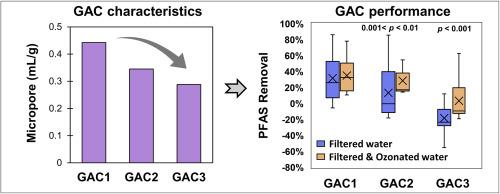Enhanced removal of trace-level per- and polyfluoroalkyl substances (PFAS) from drinking water using granular activated carbon (GAC): The role of ozonation
IF 8.1
2区 环境科学与生态学
Q1 ENVIRONMENTAL SCIENCES
引用次数: 0
Abstract
Granular activated carbon (GAC) is a promising approach for removing per- and polyfluoroalkyl substances (PFAS) from drinking water. However, GAC filters usually suffer early PFAS breakthroughs due to the competition between PFAS and natural organic matter (NOM) during sorption. The present study investigated the possibility of using ozonation to enhance the GAC performance for PFAS removal. Rapid-small-scale-column tests were performed for three GACs using filtered or filtered and ozonated water. NOM was fractionated using liquid chromatography-organic carbon detection (LC-OCD), and 76 ambient PFAS were quantified using ultra-high-performance liquid chromatography coupled with high-resolution mass spectrometry (UHPLC-HRMS). Although ozonation did not remove either NOM or PFAS, it altered their composition in water. Ozonation reduced the hydrophobicity and the molecular size of natural organic matter (NOM). On the other hand, ozonation oxidized some PFAS precursors, leading to a higher total detected PFAS concentration in the filtered and ozonated water than in filtered water (10.2 ± 0.7 ng/L vs. 9.5 ± 0.7 ng/L). The impact of ozonation on GAC performance for NOM and PFAS removal mainly depended on GAC properties. GAC with a lower micropore volume showed an improvement in NOM and PFAS removal when ozonation was applied, approaching the performance of GACs with higher micropore volumes.

使用粒状活性炭 (GAC) 增强去除饮用水中痕量全氟和多氟烷基物质 (PFAS):臭氧的作用。
颗粒活性炭 (GAC) 是一种去除饮用水中全氟化烃和多氟化烃物质 (PFAS) 的有效方法。然而,由于在吸附过程中 PFAS 与天然有机物(NOM)之间的竞争,GAC 过滤器通常会在早期出现 PFAS 突破。本研究探讨了利用臭氧来提高 GAC 去除 PFAS 性能的可能性。使用过滤水或过滤水和臭氧水对三种 GAC 进行了快速小规模柱测试。使用液相色谱-有机碳检测法(LC-OCD)对 NOM 进行了分馏,并使用超高效液相色谱-高分辨质谱法(UHPLC-HRMS)对 76 种环境中的 PFAS 进行了定量。尽管臭氧处理并未去除 NOM 或 PFAS,但却改变了它们在水中的组成。臭氧处理降低了天然有机物(NOM)的疏水性和分子大小。另一方面,臭氧氧化了一些 PFAS 前体物质,导致过滤水和臭氧处理水的 PFAS 总检测浓度高于过滤水(10.2 ± 0.7 纳克/升 vs. 9.5 ± 0.7 纳克/升)。臭氧对 GAC 去除 NOM 和 PFAS 性能的影响主要取决于 GAC 的特性。微孔体积较小的 GAC 在使用臭氧时对 NOM 和 PFAS 的去除率有所提高,接近微孔体积较大的 GAC 的性能。
本文章由计算机程序翻译,如有差异,请以英文原文为准。
求助全文
约1分钟内获得全文
求助全文
来源期刊

Chemosphere
环境科学-环境科学
CiteScore
15.80
自引率
8.00%
发文量
4975
审稿时长
3.4 months
期刊介绍:
Chemosphere, being an international multidisciplinary journal, is dedicated to publishing original communications and review articles on chemicals in the environment. The scope covers a wide range of topics, including the identification, quantification, behavior, fate, toxicology, treatment, and remediation of chemicals in the bio-, hydro-, litho-, and atmosphere, ensuring the broad dissemination of research in this field.
 求助内容:
求助内容: 应助结果提醒方式:
应助结果提醒方式:


